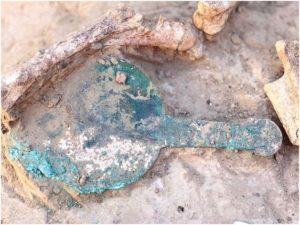
PLOS—Scythian people of ancient Ukraine led more complex lives than commonly assumed, according to a study published March 10, 2021* in the open-access journal PLOS ONE by Alicia R. Ventresca Miller of the University of Michigan and colleagues.
The Scythian people, who lived across the Pontic steppe around 700-200 BCE, are often portrayed as a culture of nomadic warriors. But this idea is challenged by archaeological evidence that indicates a more complex and varied culture at this place and time. In this study, researchers employed isotopic analyses to investigate patterns of diet and mobility in Scythian populations.
The authors measured isotopes of carbon, nitrogen, oxygen, and strontium in human teeth and bones from several Scythian-era burial sites in Ukraine. Isotopes that reflect diet, indicate that in some places there was a varied diet including numerous domesticated crops, while isotopes that reflect geologic surroundings indicate that most people did not travel long distances during their lifetimes.
These results support the growing understanding that Scythian populations were not a homogenous culture, but a more diverse group which, in some places, lived more sedentary lives with a dependence on agriculture. The authors suggest that future studies should expand this work to compare multiple generations of people over more varied geographical locations. This work will help archaeologists move toward a more complete idea of what it meant to be Scythian.
The authors add: “Our multi-isotopic study challenges romantic notions of wide-ranging Scythian nomads. We show that while some individuals from classic Scythian contexts traveled long distances, the majority remained local to their settlements, farming millet and raising livestock in mixed economic systems.”
________________________________

Bronze mirror found at the site of Mamai-Gora. Svetlana Andrukh (CC-BY 4.0, https://creativecommons.org/licenses/by/4.0/)
________________________________
Article Source: PLOS news release
*Ventresca Miller AR, Johnson J, Makhortykh S, Gerling C, Litvinova L, Andrukh S, et al. (2021) Re-evaluating Scythian lifeways: Isotopic analysis of diet and mobility in Iron Age Ukraine. PLoS ONE 16(3): e0245996. https:/
________________________________
Advertisement




